Riverside House
20 Garford Street, Limehouse, E14 8JG
Medical
dates:
Medical
character:
Inebriates
In 1929 the Salvation Army
took over Riverside House, the former Scandinavian Seamen's Temperance
Hostel, which had closed the previous year following the death of its
founder and manager, Agnes Welin, a missionary of the Swedish Free Church.
After some alterations, the building was officially reopened on 18th February 1930 by the Salvation Army's General Edward Higgins as the East London Hostel for homeless men.
The stark, unadorned 5-storey building accommodated 241 men and 22 resident staff. Space was limited - a room measuring 22 ft 9 in (6.9 metres) by 17 ft (5.2 metres) would contain 12 beds. More beds were available in the neighbouring Greig House, which had been built in 1902 to provide separate accommodation for the officers of the Scandinavian ships. Part of the gatekeeper's lodge became known as the Chinese Room, probably because it housed homeless men from the local Chinese community.
The hostel gradually filled with a greater proportion of elderly homeless men. In 1974 the building had to be altered to comply with the legal minimum standards for housing the elderly. However, after the work was completed, the Salvation Army decided to use it to accommodate alcoholics instead.
Following a major fire in 1981 there were proposals to close the building and demolish it, as it was deemed too outdated for modern accommodation. However, an extensive programme of improvement was carried out instead, at a cost of £900,000. The detached single-storey wash-house to the south of Riverside House was also upgraded. The lodge, store and covered yard near the street were converted into a recreation room, offices and workshops. The former stables along the east boundary wall were demolished.
The buildings reopened in 1983 with 96 beds. They were used for a short while to house homeless young people, but later became used again for alcoholic men.
After 20 years the Salvation Army decided to close the hostel. Originally designed for short-term stays by seamen who required little privacy, it was considered that the accommodation was no longer appropriate for the needs of medium-stay residents.
The Riverside House complex closed in June 2003.
After some alterations, the building was officially reopened on 18th February 1930 by the Salvation Army's General Edward Higgins as the East London Hostel for homeless men.
The stark, unadorned 5-storey building accommodated 241 men and 22 resident staff. Space was limited - a room measuring 22 ft 9 in (6.9 metres) by 17 ft (5.2 metres) would contain 12 beds. More beds were available in the neighbouring Greig House, which had been built in 1902 to provide separate accommodation for the officers of the Scandinavian ships. Part of the gatekeeper's lodge became known as the Chinese Room, probably because it housed homeless men from the local Chinese community.
The hostel gradually filled with a greater proportion of elderly homeless men. In 1974 the building had to be altered to comply with the legal minimum standards for housing the elderly. However, after the work was completed, the Salvation Army decided to use it to accommodate alcoholics instead.
Following a major fire in 1981 there were proposals to close the building and demolish it, as it was deemed too outdated for modern accommodation. However, an extensive programme of improvement was carried out instead, at a cost of £900,000. The detached single-storey wash-house to the south of Riverside House was also upgraded. The lodge, store and covered yard near the street were converted into a recreation room, offices and workshops. The former stables along the east boundary wall were demolished.
The buildings reopened in 1983 with 96 beds. They were used for a short while to house homeless young people, but later became used again for alcoholic men.
After 20 years the Salvation Army decided to close the hostel. Originally designed for short-term stays by seamen who required little privacy, it was considered that the accommodation was no longer appropriate for the needs of medium-stay residents.
The Riverside House complex closed in June 2003.
Present status (March 2014)
Apart from Greig House, which is Grade II listed, the Riverside House buildings were demolished. Two 5-storey purpose-built apartment blocks - Riverside House and Matthew House - were erected in their place.
The new Riverside House is a direct access hostel with 40 rooms, while Matthew House is a resettlement hostel with 20 one-bedroom apartments. The fourth floor of Riverside House contains the Harbour Recovery Centre with 8 in-patient beds for men aged over 18 years recovering from drug addiction.
Greig House is now a Residential Detoxification Centre with 20 beds for men and women with drug and alcohol problems.
The site is run by the Salvation Army Housing Association as the Riverside House Lifehouse.
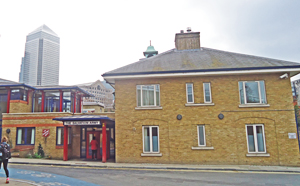
The new entrance in Garford Street (above and below).
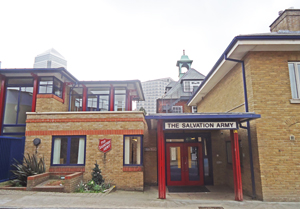
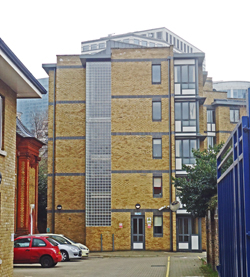
The new Riverside House.
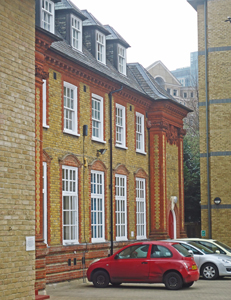
Greig House opened in 1903 as an annexe for the officers of Scandinavian merchant ships. It was built on concrete piers reaching from the gravel bottom through a stratum of waterlogged mud about 12 feet (3.7 metres) deep.
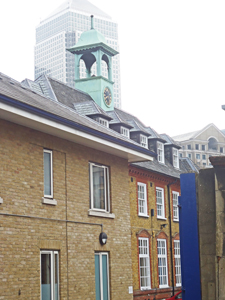
Greig House and its clocktower are just visible through the surrounding builings of the Riverside House site.
http://edithsstreets.blogspot.co.uk
http://modgov.towerhamlets.gov.uk
http://planreg.towerhamlets.gov.uk
www.best-maritime-employment.unfo
www.british-history.ac.uk
www.pinterest.com
www.portcities.org.uk (1)
www.portcities.org.uk (2)
www.scottisharchitects.org.uk
Return to home page